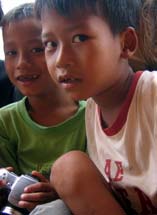Semester at Sea Fall
2006 Voyage 
- Home
- Lara's Bio
- Multi-sited
Ethnography: English Language Acquisition
- Life Herstory Interview
- Hawaii:
Surfer Boys
- Japan: Saki Balm
- China: Migration as a Hobby
- Vietnam: Balancing a Language
Barrier
- Burma: Juvenile Multi-linguists
- India: Princess of Erode
- Egypt: Belly Dancing
Double-Standard
- Turkey: Turkish Delights
- Open Letter
English Language Aquisition



INTRODUCTION
Most of my favorite field observations involve conversations and interactions between myself and others within the culture I’m visiting. Due to my own limited abilities in the realm of foreign languages, these interactions are almost always conducted with people who have learned English as a second language. Because of this, I’ve become increasingly interested in the hundreds of different reasons, ways, and processes involved in English language acquisition for non-native speakers.
Whether through school, independent study, business, or necessity, each of the people that I survey and write about have in some way attained a working (or semi-working) knowledge of the English language. Through observing and documenting my own communications, I hope to assemble a multi-sited ethnography about the different relationships each of these people have with the English language, and better understand my own connection to the language and others that I might one day finally learn.
In
this specific ethnography project, I’ve decided to focus mainly on
children,
since their language acquisition is for the most part inadvertent, and
more
accurately reflects their socio-cultural circumstances. Given the right
attention and resources, anyone can learn a foreign language, for
whatever
reason they choose. If I wanted to, for example, I have the opportunity
to take
lessons in Tagalog or Swahili, but any studies on the subject would be
rather
bland, or more biological than cultural. This study focuses on the
ever-increasing necessity and demand on young people worldwide to
assimilate
into a rapidly growing English-dominated world.
NARA - Saki Balm - JAPAN
BAGAN - Juvenile Multi-Linguists - BURMA
ERODE - Princess Vidhya of Erode - INDIA
ANALYSIS
Saki comes from
a relatively
well-off family in a farming village on the outskirts of
I couldn’t gather much information about Saki’s formal training in English, because other than simply asking about her school, communicating a complex question about the methods or motives was difficult. In his article Doing Feildwork in Japan, Theodore Bestor talks about the difficulties of getting people to talk about their own social and working environments, because they don’t understand why it would be something of interest to a foreigner. Most of the questions I posed to Saki’s older cousin, Yuki, about Saki’s or her own schooling were met with puzzled expressions and vague answers. I feel like she didn’t see the relevance of my inquiries. Already feeling (undeservedly) insufficient in her own English, she may have even felt like I was challenging her. Whereas, quite contrary, I was impressed.
Yuki
attends
Konan Women’s University in
I tried to put myself in Saki’s position, imagining a foreign exchange student in my own home when I was eight. I could approach her confidently and say, “Hola! Me llamo Lara.” I’d go to school the next day and tell my teacher, Mrs. Cuevas, all about it and she’d give me a big yellow star sticker, and I’d never understand the significance past contentedly doing what was expected of me. Not until now, anyway.
In a separate vein, there’s another eight-year-old who I feel full-well understands the significance of her English comprehension. Whereas Saki, at age eight, has very little to loose for not completing her vocabulary assignments or coloring-book language labs, little Aung Kyaw has everything to loose. Talking to her on the Ananda pagoda, her eyes looked ancient. Saki, intrigued by my difference and enchanted by the unknown, was bouncy and eager for my acceptance and attention. Aung Kyaw was bouncy like an eight year old, but much more eager for my money than anything else. Acceptance and attention come secondary to food and clothing.
As much as I didn’t want to be hounded and taken advantage of, I know Aung Kyaw’s plight. She lives her life day to day this way, waiting for dollars, Euros, British pounds, anything to keep eating, keep living, and keep from being displaced by the government. The only thing she has control over is how hard she works, and even that depends on others. Namely, in this case, me. In her article Darker than Midnight; Fear, vulnerability, and terror making in urban Burma (Myanmar), Monique Skidmore makes a point that denying fear is the most common survival strategy for the people in Burma. In a place where nothing is certain and everything is dangerous, that is all that can be done. The hard expression that blazed out of Aung Kyaw’s eyes as she thanked me for my contribution to her cause, was this denial of fear. This understanding, beneath the tiny hands and baby voice, that English is currency, and there’s no room for apprehension.
In Vidhya’s case, there’s simply no reason for apprehension. That girl spoke better English than most ten-year-olds in the States do, and I’d bet money she could beat me in a spelling bee, as well. As she confessed to me during our discussion about Harry Potter, Vidhya learned all of her English in school, and all of her Tamil at home (therefore, verbal only). Vidhya said that in school, Tamil is her worst subject. She takes it like an elective, as if learning to read and write a second language that she already speaks.
Visiting
a
school similar to Vidhya’s in a nearby district of Tamil Nadu, I
learned that
starting in the first grade, the students have “English days.” Two to
three
times a week, all lessons and instruction are given in English, and all
discussion and assignments must also be in English. By the time most
students
reach high school, they have developed the language patterns necessary
to
converse efficiently in both English and Tamil. In fact, several
students adapt
a habit of speaking Tamil, the language they’ve heard since birth, in
conversational dialogue, and switching to English when their discussion
is
academic in nature. I’ve heard of this kind of sink-or-swim immersion
technique
done in grade schools in areas of French Canada, to insure that
children
growing up in households speaking only French or only English become
fully
capable and fluent in both, since speaking both is increasing becoming
a
requisite of living in the area. However, it is fascinating to me that
such an
advanced and demanding instruction program occurs in a small farming
village in
Though
it
initially took me a while to see it, clearly Vidhya’s (and her mother’s
and
sisters’) academic situation is a result of their caste. Sara Dickey
explains
in her article Lives in Madurai that
the caste system, though contemporarily unsanctioned, determines
everything
from marriage arrangements, living conditions, occupation, and goals
for
education. In so many of my field studies, I can’t help but reflect
endlessly
on the unfairness and guilt I feel for having just been “tossed the
lucky
coin,” being born in the right place at the right time. Opposed to Aung
Kyaw in
English is
becoming an increasingly dominant language in today’s world. Children
have an
outstanding ability for acquiring languages, and in this generation
more and
more children are beginning to study languages that even their parents
never considered.
I believe that by further studying this pattern of English language
acquisition
in children we can better understand the practical migratory patterns
of the
language. Whether for purposes of affluence, education, business,
necessity, or
privilege; the prevalence of English as a second language is
ubiquitous. Having
made my way around the globe to witness it with English as my mother
tongue, I
am personally beginning to find it absolutely unacceptable for me to
remain
monolingual.